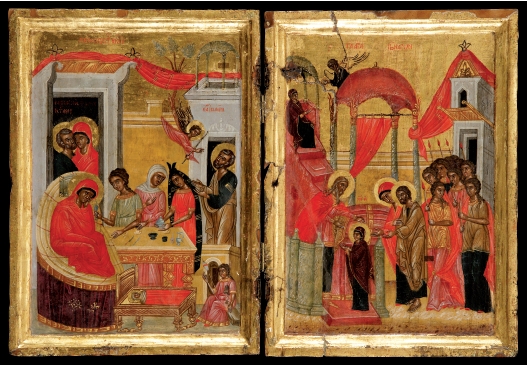
- Diptych icon with the Nativity of Virgin and the Entrance of Virgin into the temple
- Item ID : 29
- Collection Name : Holy Metropolis of Zakinthos and Strofadon
- Year : Late 16th century
- Τechnique : egg tempera
- Materials : wood
- Dimension : 26 x 37.5 x 2
- Description : left wing of the diptych – The Nativity of Virgin (a)
The left wing of the diptych depicts the Nativity of Virgin. The wooden panel is slightly hollowed out so as to form a narrow raised border all around. The scene unfolds against a background of schematically rendered buildings on either side rising out from the ground. A red fabric is spread over the buildings so as to indicate that the event took place indoors. On the left side of the icon mother of Virgin is depicted full length tenderly watching the newborn Virgin. Behind her the customary depiction of the Meeting of Joachim and Anne embraced is rendered inside of a building in perspective. On the right side Saint John the Evangelist is depicted almost half length watching a flying angel that declares the event. The stylization of the composition employed comes from the metropolitan art of the Paleologian period.
Description: right wing of the diptych – The Entrance of Virgin into the temple (b)
The right wing of the diptych depicts the three years old Virgin entering the temple to be consecrated to the service of God. She is accompanied by Her parents Joachim and Anne. Preceded by young girls with lighted candles, she entered into the Holy of Holies. Mary enters into the Temple to prepare herself to later become the Temple of the body of Christ. High Priest Zacharias stands on the steps receiving Her at the dwell of God. Mary stretches her hands toward him.
On the upper left side of the icon Virgin is depicted at a smaller scale by an angel. She is to be nourished by “heavenly bread.” The virgin does not look like a child except in size because already she is a “mature” or perfect person. The style of the icon has a mystical and ascetic character, resembling esoteric life.
The presence of the Cretan School of art stereotypes is well observed.


